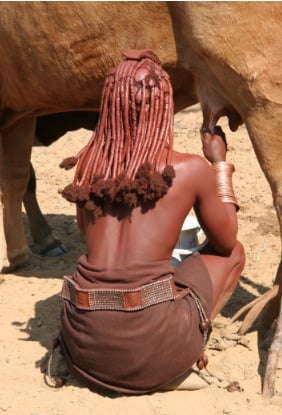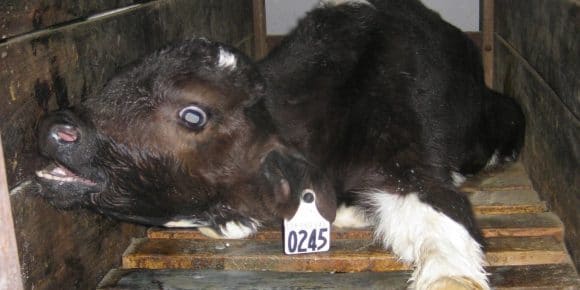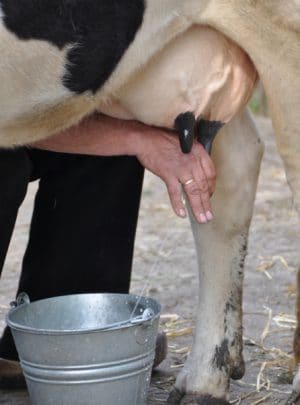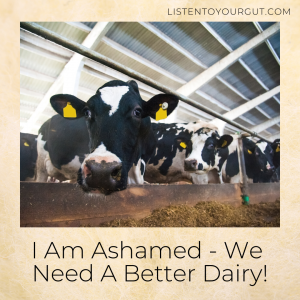Dairy farming, like all factory farming, has gone horribly wrong in the last 70 years, making it an ethical nightmare for those who consume this highly nutritious food.
Let’s start with what’s gone wrong with dairy farming and then let’s move into real, actionable solutions – humane solutions already being carried out by dairy farmers in North America and Europe. Yes, there’s hope!
You may have already seen this video – it does a fantastic job of summing up what’s wrong with the dairy industry (even organic dairy) in less than 5 minutes:
I was so disturbed by this video that I started talking to dairy farmers. Call me naive, but I actually had NO IDEA calves were taken from their mothers right after birth! Somehow, I still had the old saying “One teat for the farmer, one for the calf” running in my head. What happened to that?? What happened to sharing the milk?
 The Masai of Kenya live off of cow’s blood and milk and the calves live with their mothers and they all live long, healthy lives. Other tribes and people that live with their animals don’t separate the calves and cows. Why doesn’t it work that way here?
The Masai of Kenya live off of cow’s blood and milk and the calves live with their mothers and they all live long, healthy lives. Other tribes and people that live with their animals don’t separate the calves and cows. Why doesn’t it work that way here?
The first farmer I talked to was a commercial dairy farmer (not organic) for about 20 years and now he grows hay. I asked him why the calves cannot be left with their mother and he replied, “Oh you can’t do that, the calves will get scours (diarrhea) because the mother produces too much milk and the calf won’t stop drinking.”
As our discussion progressed, he enlightened me further, “In the old days, a cow that produced 60 pounds of milk a day was considered a good producer. Now, the cows produce 160 pounds a day and if you had one that only produced 60 pounds, you’d get rid of her. So the calf just keeps drinking, doesn’t know when to stop, and it gets sick.”
Well, can’t you separate the calves during the day, and just let them be with mum at night?
“Oh no, that mother will just stand at the fence and call all day for that calf if the calf is anywhere on the property. She won’t eat or nothing, so we can’t do that. But I used to leave the calves with the mother for a week. That way they could get the colostrum and get a good start in life. And I just couldn’t take them away from the mother any earlier. All the other farmers would tell me I was crazy for doing that and giving up that much milk. But I just couldn’t take them any earlier.”
When calves are taken from their mother – usually right after giving birth, they are fed powdered milk formula. The ones that are kept for veal go to places like this until they are slaughtered:

Veal Farm (c) Rosemary Wright

Veal farm in Quebec, Canada
Then I went and talked to a raw milk farmer – whose cows are out on pasture. If you’ve read any of the posts on raw milk here on my blog, you’ll know that these cows must be kept really healthy for the milk to pass the frequent testing (which is much more stringent than the testing for pasteurized milk).
The raw milk farmer told me that he leaves the calves with the mother for about a week or so and then they are separated. The calves are fed raw milk. The females become milk cows and the males are grass-fed until they are slaughtered for beef. He said his milk cows live about 20 years.
I know most people’s solution to this horrific practice is to stop consuming dairy. That’s one solution. But how about the billions of people worldwide who will never give up their cheese, or cream in their coffee, or whey protein shakes? I always teach my kids that whatever you pay for, you are supporting. WE are the one keeping these practices going, we are the enslaver, we are the ones ripping the baby away from the mother.
So I would gladly pay 2 or 3 times the price to purchase dairy where the calf is left with the mother for… I don’t know… I have no experience with cows or their growth etc. but I would guess… at least 4-6 months? And when it is time to wean, how about using a more humane method, like QuietWean?
I remember when organic food was considered ridiculous. I was mocked by everyone including family members for paying ‘outrageous prices’ to support the organic food movement. 20 years later, guess what? Yep. Every single one of those nay-sayers is regularly buying and eating organic food.
I believe dairy needs to follow the same path. I have not even looked into how goats or sheep are treated when farmed for their milk. But as a mother who has given birth 3 times, I cannot imagine the horror of having your baby taken moments after birth and then your breasts pumped incessantly for their milk until you die when you’ve reached 1/5 of your normal lifespan. So for a human, that would be what… you birth your first baby at age 12 or 13 and you’re dead by 16?
I would like to start a conversation – not about the horror – but about practical solutions to dairy farming that take the mother’s soul into account. I know I must have some readers that farm, or know dairy farmers… can we please start a dialogue of ideas, problems, experiments, possible solutions, in the Comments section below?
Are there any small raw milk farmers who are currently leaving the calves with the mother and harvesting a humane, sustainable amount of milk?
Solutions – YES there IS a better way!
After publishing this post, one of my readers shared the link to Traderspoint Creamery in Indiana where the cows are kept out on pasture, together with their calves:
“After birth, our calves enjoy a life that reflects the way they entered it – in the great outdoors, amongst the herd, in harmony with nature’s design. By remaining with their mothers and the other cows, calves can nurse on rich milk and learn the dynamics of herd life from the other animals. Occasionally a calf will have to be bottle fed in the early days until it gets the hang of nursing, but always the intention is to keep the babies integrated with our grassfed herd. Once a cow has given birth, she rejoins the milking herd and resumes our twice daily milking – able, as she is, to provide enough milk for her calf and us humans. Her calf dutifully follows her up to the milking parlor and back out to the pastures, hanging out with other calves as they wait for their mothers to emerge from the parlor.”
At almost the same time, I found The Calf At Foot Dairy in the UK where the calves are likewise kept with their mamas on grass for 9 months. The mothers willingly walk into the milking parlour:
“On top of this our cows are completely unrestrained for milking, unlike in a normal parlour – they each know their name, come to call and run in by themselves!”
So there we have it – two commercial dairy farmers, on separate continents, harvesting milk in a humane, loving way.
The first large-scale test project of what the UK is calling Ethical Dairy, began in 2017. Unfortunately, they didn’t have anyone heading up the project who had already done it on a smaller scale, or who had any idea what they were doing! So the learning curve was steep and long, but it was still going in 2019.
In 2020 Scotland gave a grant to dairy farmers to run two pilot projects on two separate dairy farms to see if the calves can be kept with their mothers for 5 months – they too are calling it Ethical Dairy.
However, there is also a farm in New York who has been successfully producing dairy this way for over a decade and they leave the calves with the mother for 10 months! They call their protocol the Madre Method:
“Eight years ago we began raising our replacement heifers one-to-one on their mother. We have tried numerous other methods, but found all fall short. Most dairy farmers dismiss the technique of cows raising their own calf. They fear a financial disaster if they don’t sell all the milk from all of their cows.
We have seen that a cow raising her own calf for an entire lactation, as nature designed, is by far the best method of raising calves; it produces the healthiest, strongest, most disease-resistant, most resilient cows. In our opinion it is the only way to raise calves in a grain-free herd. It is also by far the most economical method for raising young stock.”
I also heard from a reader who was involved in a cow share – where one cow supplied enough milk for 10 families and the cow was allowed to keep her calf for 3 months. So even on a very small scale, this can be done in a much more humane way. Here is a summary of her experience:
“The cow belongs to my friend who takes general responsibility for the cow… vet visits and bills, living arrangements, feed, etc. The other families that “rent” the cow contribute monetarily, donating whenever possible – about the amount that we have calculated would be needed to maintain the cow for that day.
I have been milking with her for the last 2 years. I take two of my daughters with me each time we milk. One helps me milk and the other cleans the pen and feeds the cow and the other animals my friend has on her small farm. It has been a great experience for our family. My family is moving in a week, and I will certainly miss having fresh, raw milk to feed my family. Here are some more details:
1. I have been there for the birth of two calves. The calves were allowed to stay with mom for about 3 months.
2. Weaning at 3 months was my friend’s choice, since they are her animals. I got the feeling that it just became too much of a hassle to keep the calf on past that point. She sold the calves since they were both males, and she is trying to get a female to replace her cow. The calves were big enough by 2 or 3 months to make separating them from mom and cleaning the pen at milking time a little challenging sometimes. Sarah also mentioned that she thought the calf was contributing to the cow developing mastitis, as it preferred to only drink from certain quarters. After the calf is gone, the milk is creamier, and there’s much more of it.
3. When we weaned the calves they went into a pen adjacent to the cow for about another month before going to their new homes. They were fed formula and grass.
4. The cow has been impregnated every year since I have been milking. I don’t know what my friend will choose to do once she gets her female calf. She does live breeding with a miniature bull because she wants a smaller cow next time, and also I think to minimize risk of injury to her current cow.
5. As far as I know, the cow has not been given a “rest year”, although we do stop milking for the last few months of the pregnancy and for the first few weeks after birth.
6. As I said above, I have been doing this for about 2 years. My friend bought the cow from a dairy when the cow was a couple years old, and has been sharing the milking with other families for 4 or 5 years. It’s my friend’s first cow, so I can’t really give you lifespan information. As far as health problems, the only thing I have seen and dealt with is a few bouts of mastitis. One of the cow’s teats was damaged by the milking machines during her time at the dairy, and that is usually the only quarter that becomes infected. During the treatments for mastitis, we still milk the cow, but discard the milk.
I hope this information helps.”
What we can do is to SHARE these stories with other people and especially with dairy farmers. Most probably do not even know this is possible!
The articles I read on why it is ‘not good to keep calves with their mothers’ were either outright propaganda pieces, or, told from the perspective of a dairy farmer who has always separated calves soon after birth. These farmers have no concept of the sentience of animals, nor do their cows show any semblance of ‘normal’ herd-family behaviours – how could they?? This is generational violence and abuse in bovine form – and then you justify the abuse by saying the sequentially-traumatized mothers are ‘bad’ mothers and don’t care about their calfs?
A cow who has been brutalized from the day she was born, used for her mammary glands only, treated as a financial object, and trained into learned-helplessness, is not going to be a calm, caring, well-adjusted mother, is she? That’s like expecting a girl born to a prostitute, taken from her mother at birth to live with other prostitute’s children, who were also taken at birth, to mature into a woman capable of being a good mother to her own child. No, that woman is going to be an anxious, depressed, uncaring, dissociated, unbonded mother – because that’s all she knows, and the neural pathways for connection and nurturing were never developed.
A cow rescued from a dairy farm is likewise not going to be a good mother the first time her calf is left with her. Because she has been trained to have that calf taken away, just as she lost her own mother. The cow will need to be taught and encouraged to be a good mother. And it will take time for her to trust/believe that her calf won’t be stolen away from her. According to farmer David Finlay in the 2017 UK pilot project,
“The first year was disastrous,” he says, admitting that he wanted to call it quits. “We just couldn’t get the cows away from the calves and into the milking parlour. For weeks we’d be dragging the cows in there. It took a long time for them to trust that the calves were still going to be there when they came back. It was so much stress as the cows just weren’t used to it and didn’t know what the rules were.”
No one is saying that changing to humane or ethical dairy will be easy. But will it be worth it? Is this part of BEing the change we want to see in our world – to become a more connected, compassionate community?
I first wrote this article in 2016 and updated it January 2021 – look at how much positive movement we’ve seen in the last 4 years alone! Look at how sales of nut/plant milks have grown – the dairy industry must evolve.
Share this article with farmers you know, and grab any opportunity you have to purchase ethical or humane dairy. Nothing can change ‘standard practice’ faster than money – consumer demand. Let’s use the one tool we all have at our disposal and vote with our wallet.
![]()
Jini Patel Thompson is an internationally recognized expert on natural healing for digestive diseases. She healed herself from widespread Crohn’s Disease and has remained drug and surgery-free for over 20 years. Jini has appeared on numerous podcast, TV, and radio shows throughout the U.S., U.K., Canada, and Australia, giving people hope and vision for how they can heal their Colitis, Crohn’s, Diverticulitis and Irritable Bowel Syndrome (IBS), using entirely natural methods. Her books on natural healing for digestive diseases have sold worldwide in over 80 countries.


